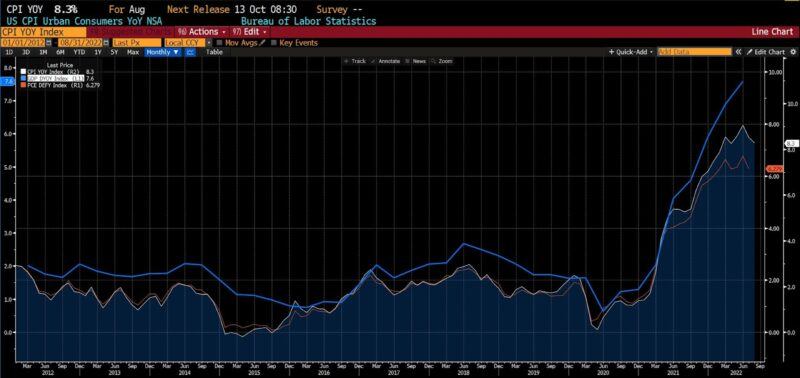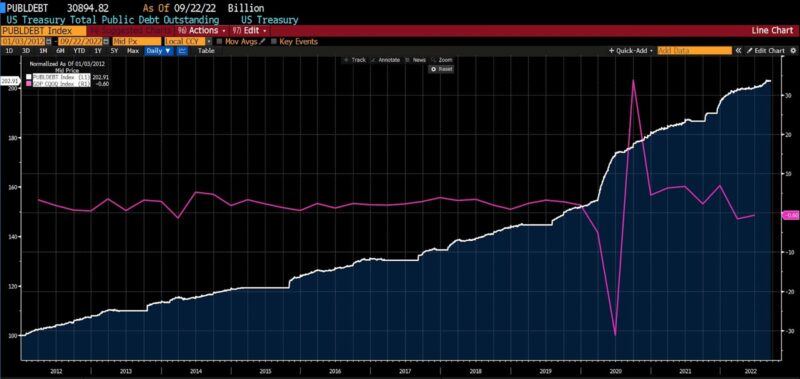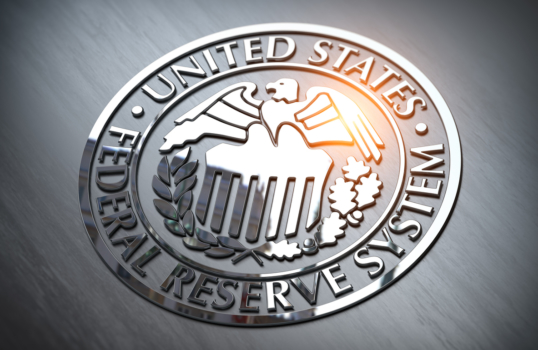Is The Fed Trying To Inflate Away US Debt?
Inflation has risen for nearly two years now. The Consumer Price Index drifted from 2 to over 4 percent in April 2021. In May 2021 it hit 5 percent, in October 2021 it surpassed 6 percent, and in December 2021 it crossed the 7 percent level. From Feb 2022 through May 2022, the monthly CPI changes were the largest they’d been in decades; in fact, there hadn’t been a 1 percent monthly CPI headline change since mid-2008. The same applies to two alternative measures of inflation: the GDP Deflator and the Personal Consumption Expenditure Price Index. All three inflation measures spent years oscillating within narrow ranges, only to rise steadily to multiples of their long-held values between early 2021 and late 2022.
Headline CPI, Personal Consumption Expenditure Price Index, and GDP Deflator, all year-over-year (2012 – present)

In the period after the massive fiscal and monetary programs employed to address the effects of pandemic mitigation measures, officials at the Fed must have been tracking prices and other data points closely. In all likelihood, they were watching more closely than usual. Several times in the summer and early fall of 2021 they publicly addressed the rising price levels, categorizing them as “transitory.” But no measures, other than assurances of their watchfulness, were undertaken to stem or slow the inflationary upsurge until March of 2022.
The delay in intervention has led to accusations of both incompetence and intentionality. Certainly, central bankers face a vast marshaling of barriers ranging from clumsy “tools,” to lag effects, to political pressures and beyond, impacting the crafting of effective monetary policies. It seems fairer to summarize those difficulties as unavoidable aspects of the insurmountable barriers associated with central planning rather than simple ineptitude, but that is a separate issue.
The latter explanation tends to be associated with the idea of the Fed or central banks more broadly as saboteurs. Rather than overmatched technocrats, central bankers are seen as cartoon villains, imbued with expert skills and inspired by tireless malevolence. To increase the population’s dependence upon government programs, to more deeply entrench elites, or for any of a number of other alleged purposes, the story goes, the Federal Reserve and other central banks are purposely permitting or even causing inflation to rise. Ironically, as in the case of 9/11 conspiracy theories, crediting governments with the ability to execute massive, intricate, perfectly timed, and executed plots–with the purported involvement of thousands of people keeping secrets for months or years—is an unabashed endorsement of the competence of bureaucrats and the feasibility of central planning.
A more reasonable explanation is that the Fed chose to let inflation run up a bit in order to accelerate the recovery from COVID lockdowns and stay-at-home orders. They overshot, though, and the increase in the general price level happened faster than expected. Additionally, those increases were difficult to distinguish, first, against broad relative price increases associated with widespread supply chain problems (late 2021), later amid price increases following the invasion of Ukraine by Russia (early 2022). And while there is now an effort to get prices back under control, the erosion of the $31 trillion pile of US debt is an unintended, but welcome, side effect.
Inflation is an acknowledged, historically vindicated salve for high and rising government debt levels. Historically, though, the effectiveness of debt debasement via inflation has depended upon several variables. Obviously, the level and persistence of inflation itself is the foremost factor. Another is the structure of the debt as measured by weighted average maturity (WAM). The WAM of US government debt has fallen from roughly 70 months (5.8 years) before the pandemic to about 65 months (5.4 years) presently. Our debt is therefore highly concentrated at the short end of the yield curve. Rising inflation tends to impact longer-term debt more than short-term debt, but some corrosive effects of decreased purchasing power will manifest in short-term government securities.
If the Treasury were to start issuing longer-term debt in noticeably longer maturities, pushing the WAM of US public debt off into the future, investors would note and likely avoid the heightened inflation vulnerability of those newer issues. Hilscher, Raviv, and Reis (2014) note the role that financial repression has played in previous episodes where debt was inflated away in real terms.
One way to increase maturity, albeit ex post, is to [bring about a] situation where the private sector is essentially forced to hold long-term debt at below-market interest rates … [I]f holders of the debt are forced to receive as payment required reserves that must be held at the central bank for N years, then this is equivalent to an ex post maturity extension. If N is as long as 10 years, then 2.5 percent more inflation on average over the next 30 years–which previously lowered the real value of debt by 3.7 percent–now lowers it by 23 percent of GDP, almost half the value of privately held debt. Of course, the side effects of such extreme repression on financial development might well be large.
What does it all amount to? Superficially, it decreases the debt to GDP ratio and makes the debt service more manageable. But lenders are fully aware that their interest payments are coming in more debased currency than was lent, which may impact their willingness to extend their outstanding loans or lend more in the future. In the current political environment, melting debt via inflation is less likely to be undertaken as fiscal housecleaning than as a measure to facilitate incurring more debt. For the government, a more pressing issue will emerge if disinflation takes longer than expected: investors will expect higher interest rates on future bonds or other securities, potentially setting up problems down the road.
US Treasury Public Debt outstanding and US GDP quarter-over-quarter (2012 – present)

More importantly, though, debt deflation via inflation threatens the economic health of citizens no less than three times in one fell swoop. Under such a policy, not only do our taxes go toward repaying debt, our purchasing power is expressly whittled away to decrease the real value of the outstanding debt load. And if the effects are successful, the government can and likely will take on more debt as a consequence. And for those troubles, citizens face a rapidly increasing chance of a recession in the next year or two. Globally, after some amount of time, demand for the US dollar would likely suffer.
The ease with which the concept is expressed as if the debt were an ice cube left on a driveway on a summer day, betrays the numerous costs associated with such a scheme. And that holds whether the undertaking is intentional or not.
*****
This article was published by AIER, American Institute for Economic Research, and is reproduced with permission.



